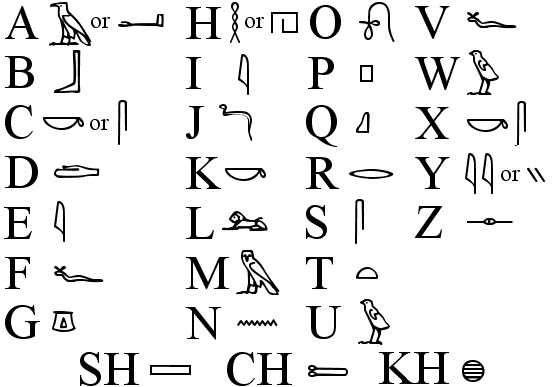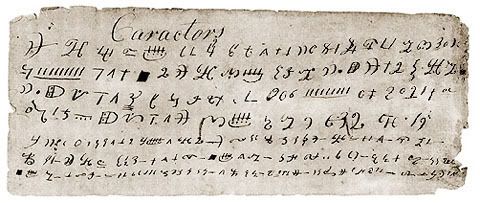Assessing the Alphabets
Part 3 of a series on Martin Harris and the Anthon Transcript
Before I get to my next post, I'll take some time to respond to John F. and Sanford's questions on my last one. Keep in mind that I am completely out of my depth here, and feel free to correct or add to my thoughts.
In the Martin Harris account of his visit to Professor Anthon that we have in the JS-H, he asserts that Anthon verified the letters as true characters from the "Egyptian, Chaldaic, Assyriac, and Arabic" languages. Historians have shown that Anthon had at least a rudimentary knowledge of these languages, enough to recognize the alphabets when he saw them. Let us assume that Martin Harris was correctly recalling the languages mentioned by Anthon. We should be able to see some correlations with these ancient alphabets and the JS characters. Below I will post some charts of the alphabets, so we can compare them with the "Caractors Document."



Ancient Assyrian (Akkadian) differs somewhat from modern Assyrian (Neo-Syrian). Akkadian was in use until about 750 BC, and was gradually replaced when writing began to be done on parchment, leather and papyrus rather than clay tablets. Aramaic gradually replaced the Ancient Assyrian because of the technological breakthrough in writing. It is sometimes assumed that Martin Harris meant to say "Aramaic" rather than "Arabic" in his report of Anthon's words because the Arabic language did not come into usage until after Lehi's group left for the New World, and would not have been represented on the plates. Arabic is descended from Aramaic and first appeared about 512 AD.
Now, here again is the "Caractors Document:"

Do you see any correlations here? I don't. It's especially disappointing to see the lack of similarity to Egyptian. In his 1834 letter to E.B. Howe, Anthon denied that the characters he saw included Egyptian, but rather wrote that he saw "Greek and Hebrew letters, crosses and flourishes, Roman letters inverted or placed sideways..." Doesn't this seem more descriptive of the characters to you?? (See especially Greek letters alpha, eta, lambda, tau, and upsilon.)

This post is intended to be a simplistic view of the alphabets as discussed by the major players in the Anthon drama. Other authors have gone into further depth on the relation of the characters to different scripts. [1] I do indeed have a working theory as to how the assertions of Martin Harris came about, but there are a few more points to cover before I get into my conclusions.
______________________________________________________________
[1] Here are only a few samples the many which are available on line.
Apologetic Sources:
Ariel L. Crowley, The Anthon Transcript: A Series of Articles in
The Improvement Era, Jan. - Mar., 1942.
Russell Littlecreek, Evidence for Reformed Egyptian. This is really cool. Click on the letters in the "Caractors Document" and you are taken to a possible corresponding Egyptian Hieratic or Hieroglyph. (Keep in mind as you do this that Professor Anthon would not have had complete knowledge of all these characters.)
John Gee, Some Notes on the Anthon Transcript:Review of Stan and Polly Johnson. Translating the Anthon Transcript.
Stanley B. Kimball, A Visit With Dr. Hayes, Sunstone, July 2002, pp. 12-13
Critical Sources:
Richard Stout, A Singular Discovery: The Curious Manuscript, Mitchill, and Mormonism. (scroll down and read about the close resemblance between the "Caractors" and Tironian notes!)
Labels: Anthon transcript, Book of Mormon, Joseph Smith, Mormon history, scripture, Sunday School









6 Comments:
Actually, I could see how Anthon could have mentioned seeing characters from those languages if we assume he saw the "caractors" you are presenting here.
But we don't know what Martin Harris showed Anthon.
We know that Harris said Anthon mentioned characters from those ancient languages. We know that Harris said that Anthon then tore up the certificate when he found out the provenance of the characters he saw (from the Golden Plates Joseph Smith said he had received from an angel). We know that nothing would or could devastate Anthon's academic reputation more than endorsing the boy prophet and his gold plates. If Harris was telling the truth about what Anthon said during his visit, then it's no wonder that Anthon described the characters the way he did in 1834.
Believers will often defer to Martin Harris's description of the encounter, believing that he was telling the truth and even believing that this really was a fulfilment of words of Isaiah as glossed by Nephi.
Non-believers or believing skeptics will not defer to Harris or may assume he was lying to further the cause and defer to Anthon's description(s) of the encounter.
I'm not sure the historical record provides a conclusive answer.
If Egyptian, by Lehi's time, wouldn't we actually be talking about Demotic Egyptian script or possibly Hieratic (i.e., the "cursive" versions of Egyptian script)? Check out the descriptions and pictures on wikipedia:
http://en.wikipedia.org/wiki/Hieratic
http://en.wikipedia.org/wiki/Demotic_(Egyptian)
Now, leaving aside the question of whether the Caractors document was what Anthon saw, if we assume it was, I can certainly see some rough eyeball resemblance (presumably about as much as Anthon might have seen).
Yes, I believe that Anthon even refers to "short-hand" Egyptian, i.e. demotic, in his earlier account, and it does not seem far fetched to think that Anthon might have seen come characters among the set presented to him that resembled demotic Egyptian. Again, we don't have the set that Harris showed Anthon.
JohnF #1
Good points--you will see more about this in my conclusions.
Non-Arab #2,
Do you know what the state of understanding of Demotic and Hieratic Egyptian was in 1828? I am currently under the impression that Anthon could not have been aware of these scripts. Am I mistaken? Your opinion: do you think demotic was a little late to have influenced writings Lehi took with him? Also, since early Demotic was used on administrative, legal, and commercial texts only, would it have been used in historical writings on plates?
JohnF #3,
I cannot find a reference to "shorthand Egyptian" in either of Anthon's letters. Do you have a reference?
Shoot, wish I could answer that BiV, no idea, I know Arabic not ancient Egyptian unfortunately (other than a couple words that survived into Coptic and made it into Egyptian Arabic). Google's gonna be a better source than me. But hey, since this is the Internet, let me throw out my own meaningless guess: I would think even if uninterpreted that documents/carvings/etchings would have been around in sufficient abundance so that scholars like Anthon would at least have been aware that there was some sort of parallel writing system even if they didn't know how to read it yet. Now back to your regularly scheduled Googling.
Sorry, I misspoke -- the reference to "shorthand Egyptian" was from an 1831 letter by W.W. Phelps in which he recounted that Harris told him that this was how Anthon had described the characters. John W. Welch has inferred that this description, however, increases the likelihood that Anthon did describe the characters this way and therefore endorse the characters as Martin Harris claimed because it would be unlikely for a simpleton like Harris to come up with this description.
Post a Comment
<< Home